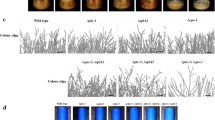Abstract
We transformed wild-type Neurospora crassa with hph gene encoding hygromycin phosphotransferase to obtain hygromycin-resistant (HygR) transformants and studied their behavior in the vegetative and sexual phases of growth. During vegetative growth in the absence of hygromycin, the hph gene was stable for at least three successive transfers with conidia. On the other hand, the behavior of the transformants in the sexual phase was different. The segregation of hph gene in the meiotic progeny was in accordance with the Mendelian ratio as inferred from PCR analysis. However, in spite of inheriting the hph gene, a proportion of the meiotic progeny failed to grow in the presence of hygromycin. This suggested that the hph gene is silenced in some progeny. The silencing effect was not confined to hph gene expression, since one-half of the meiotic progeny also showed poor conidiation. Genomic Southern analysis indicated deletions/rearrangements of the transgene in the progeny. A heterokaryon between silenced and non-silenced strains was able to grow on hygromycin-containing medium, showing that silencing was recessive. Silencing was reversed in homokaryotic nuclei extracted from such heterokaryon.
Similar content being viewed by others
Author information
Authors and Affiliations
Additional information
Received: 2 October 2002 / Accepted: 4 November 2002
Rights and permissions
About this article
Cite this article
Dev, K., Maheshwari, R. Silencing of Hygromycin Phosphotransferase (hph) Gene During Sexual Cycle and Its Reversible Inactivation in Heterokaryon of Neurospora crassa . Curr Microbiol 47, 0220–0225 (2003). https://doi.org/10.1007/s00284-002-3991-3
Issue Date:
DOI: https://doi.org/10.1007/s00284-002-3991-3




